ACCT11059: Accounting Report on Cost Relationships Analysis
VerifiedAdded on 2022/12/29
|8
|1827
|38
Report
AI Summary
This accounting report provides an overview of key cost relationships within a business context. It begins by emphasizing the importance of understanding how costs relate to various business situations and the exchange of value between a firm and its customers. The report then discusses the classification of costs into fixed and variable categories, and the distinction between direct and indirect costs, providing examples of each. It explores different costing systems, including job costing and activity-based costing, and the methods for allocating indirect costs. Furthermore, it covers absorption costing and variable costing, and the application of cost volume-profit (CVP) analysis. The report concludes by highlighting the significance of cost analysis in managerial decision-making, particularly in understanding the impact of costs on profitability and operational risk, emphasizing the importance of the breakeven point and contribution margins.
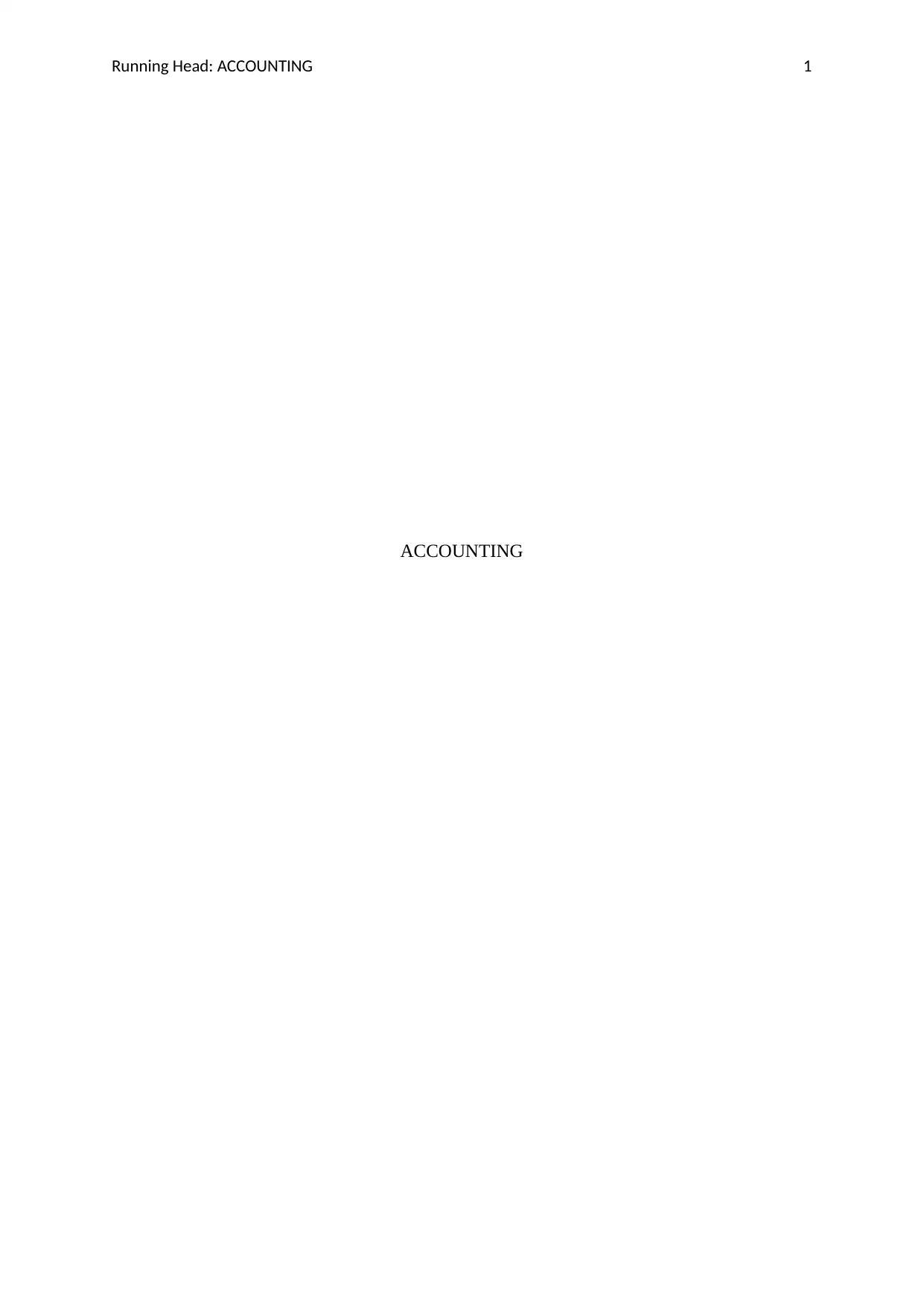
Running Head: ACCOUNTING 1
ACCOUNTING
ACCOUNTING
Paraphrase This Document
Need a fresh take? Get an instant paraphrase of this document with our AI Paraphraser
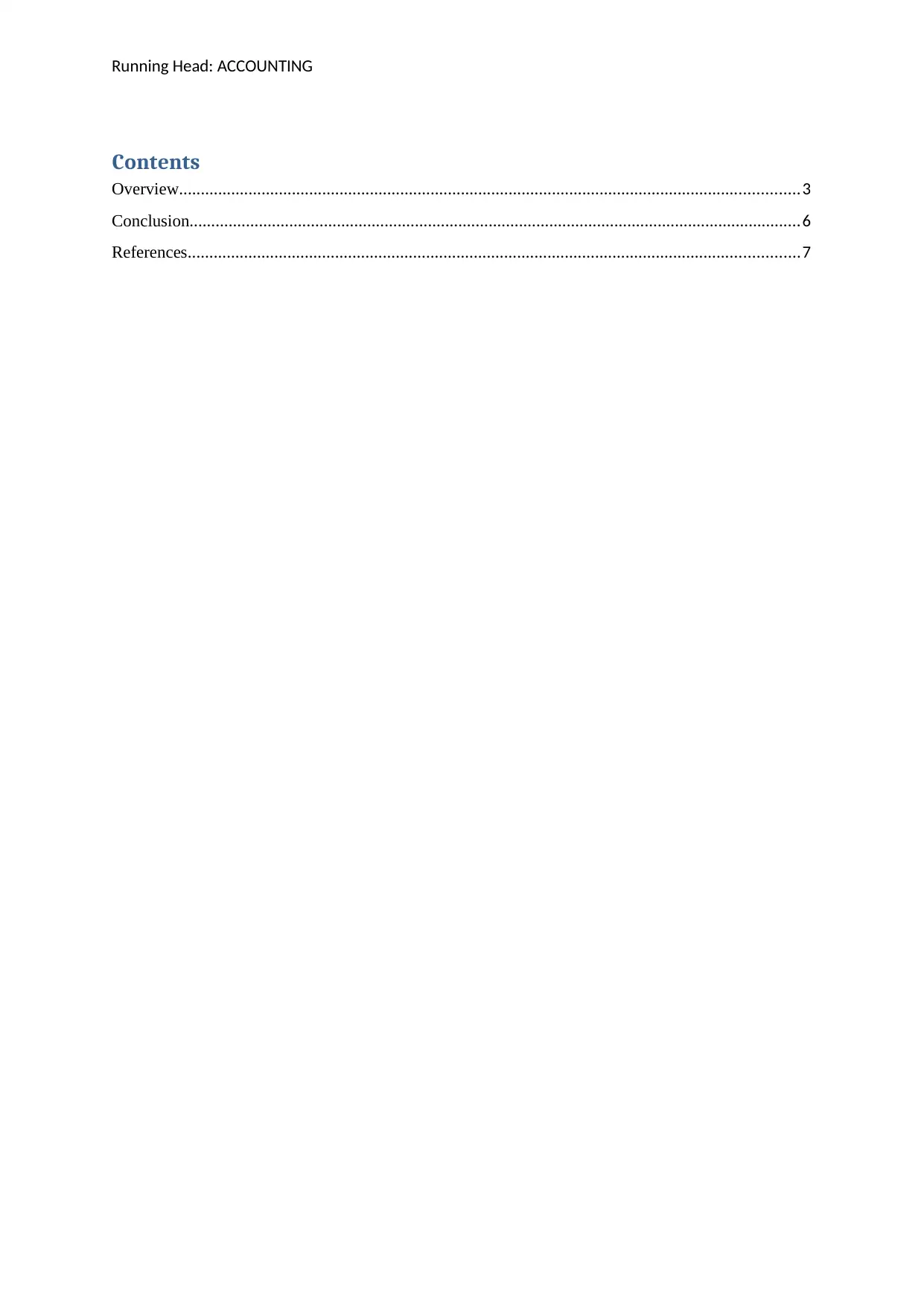
Running Head: ACCOUNTING
Contents
Overview...............................................................................................................................................3
Conclusion.............................................................................................................................................6
References.............................................................................................................................................7
Contents
Overview...............................................................................................................................................3
Conclusion.............................................................................................................................................6
References.............................................................................................................................................7
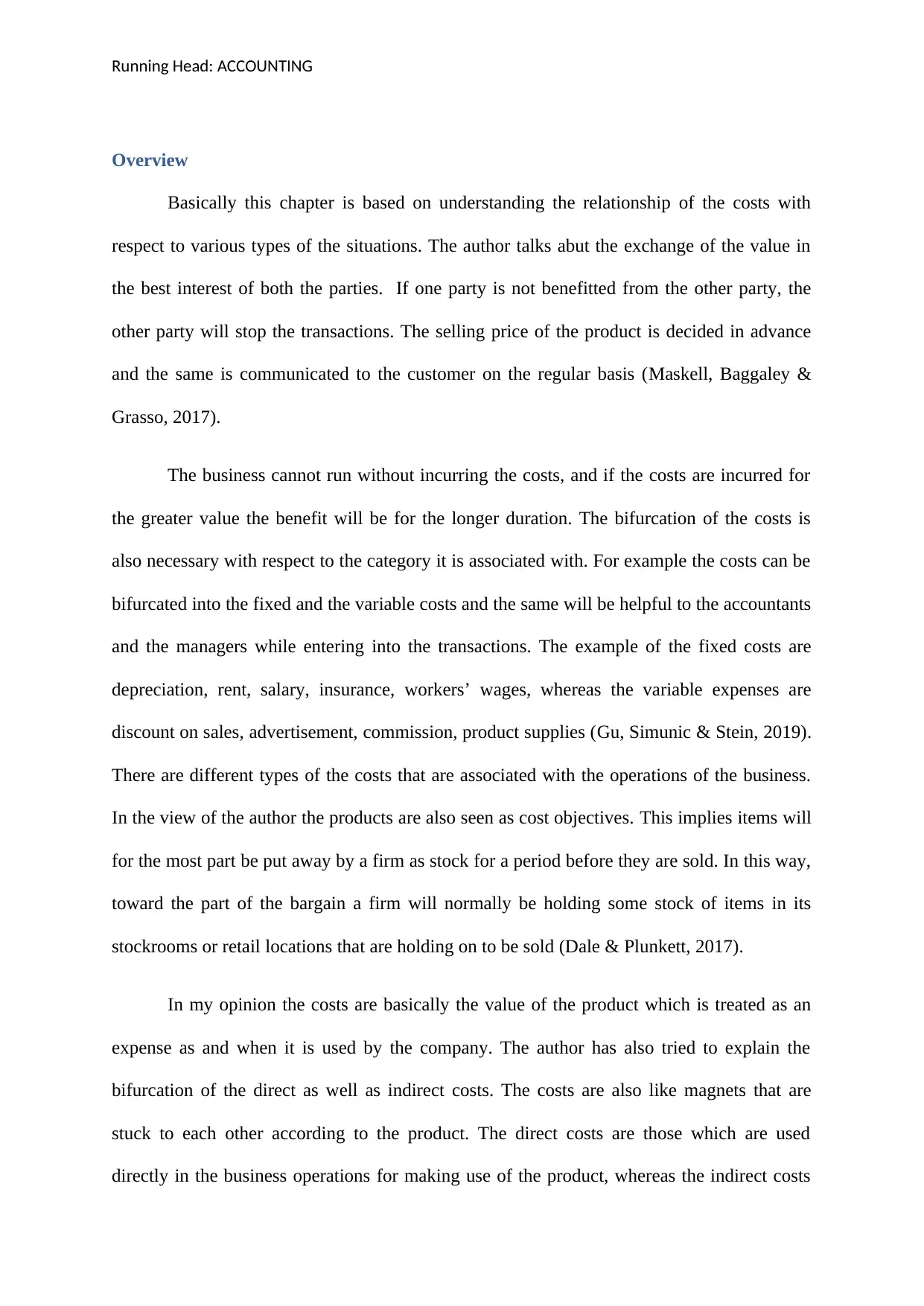
Running Head: ACCOUNTING
Overview
Basically this chapter is based on understanding the relationship of the costs with
respect to various types of the situations. The author talks abut the exchange of the value in
the best interest of both the parties. If one party is not benefitted from the other party, the
other party will stop the transactions. The selling price of the product is decided in advance
and the same is communicated to the customer on the regular basis (Maskell, Baggaley &
Grasso, 2017).
The business cannot run without incurring the costs, and if the costs are incurred for
the greater value the benefit will be for the longer duration. The bifurcation of the costs is
also necessary with respect to the category it is associated with. For example the costs can be
bifurcated into the fixed and the variable costs and the same will be helpful to the accountants
and the managers while entering into the transactions. The example of the fixed costs are
depreciation, rent, salary, insurance, workers’ wages, whereas the variable expenses are
discount on sales, advertisement, commission, product supplies (Gu, Simunic & Stein, 2019).
There are different types of the costs that are associated with the operations of the business.
In the view of the author the products are also seen as cost objectives. This implies items will
for the most part be put away by a firm as stock for a period before they are sold. In this way,
toward the part of the bargain a firm will normally be holding some stock of items in its
stockrooms or retail locations that are holding on to be sold (Dale & Plunkett, 2017).
In my opinion the costs are basically the value of the product which is treated as an
expense as and when it is used by the company. The author has also tried to explain the
bifurcation of the direct as well as indirect costs. The costs are also like magnets that are
stuck to each other according to the product. The direct costs are those which are used
directly in the business operations for making use of the product, whereas the indirect costs
Overview
Basically this chapter is based on understanding the relationship of the costs with
respect to various types of the situations. The author talks abut the exchange of the value in
the best interest of both the parties. If one party is not benefitted from the other party, the
other party will stop the transactions. The selling price of the product is decided in advance
and the same is communicated to the customer on the regular basis (Maskell, Baggaley &
Grasso, 2017).
The business cannot run without incurring the costs, and if the costs are incurred for
the greater value the benefit will be for the longer duration. The bifurcation of the costs is
also necessary with respect to the category it is associated with. For example the costs can be
bifurcated into the fixed and the variable costs and the same will be helpful to the accountants
and the managers while entering into the transactions. The example of the fixed costs are
depreciation, rent, salary, insurance, workers’ wages, whereas the variable expenses are
discount on sales, advertisement, commission, product supplies (Gu, Simunic & Stein, 2019).
There are different types of the costs that are associated with the operations of the business.
In the view of the author the products are also seen as cost objectives. This implies items will
for the most part be put away by a firm as stock for a period before they are sold. In this way,
toward the part of the bargain a firm will normally be holding some stock of items in its
stockrooms or retail locations that are holding on to be sold (Dale & Plunkett, 2017).
In my opinion the costs are basically the value of the product which is treated as an
expense as and when it is used by the company. The author has also tried to explain the
bifurcation of the direct as well as indirect costs. The costs are also like magnets that are
stuck to each other according to the product. The direct costs are those which are used
directly in the business operations for making use of the product, whereas the indirect costs
⊘ This is a preview!⊘
Do you want full access?
Subscribe today to unlock all pages.

Trusted by 1+ million students worldwide
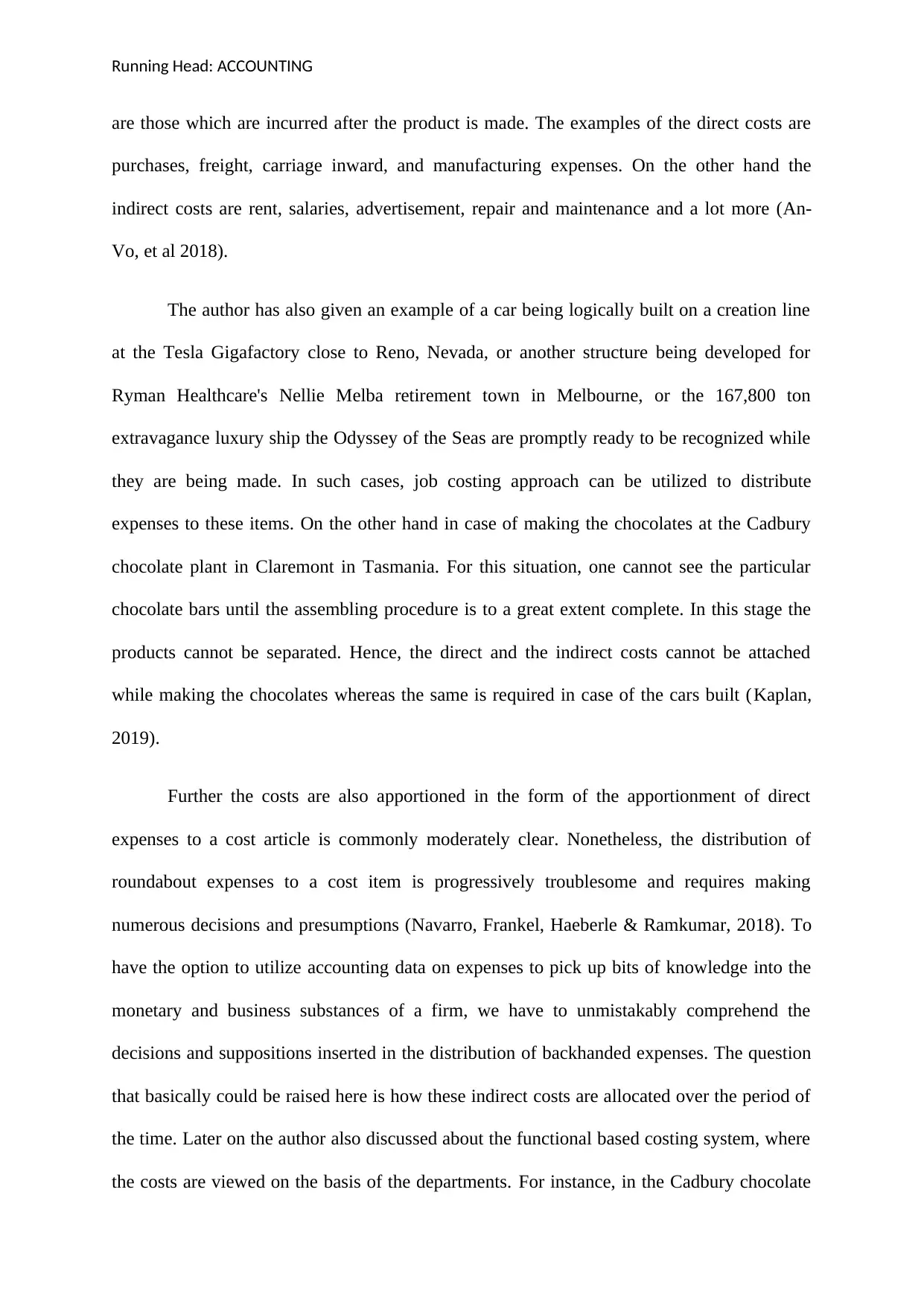
Running Head: ACCOUNTING
are those which are incurred after the product is made. The examples of the direct costs are
purchases, freight, carriage inward, and manufacturing expenses. On the other hand the
indirect costs are rent, salaries, advertisement, repair and maintenance and a lot more (An-
Vo, et al 2018).
The author has also given an example of a car being logically built on a creation line
at the Tesla Gigafactory close to Reno, Nevada, or another structure being developed for
Ryman Healthcare's Nellie Melba retirement town in Melbourne, or the 167,800 ton
extravagance luxury ship the Odyssey of the Seas are promptly ready to be recognized while
they are being made. In such cases, job costing approach can be utilized to distribute
expenses to these items. On the other hand in case of making the chocolates at the Cadbury
chocolate plant in Claremont in Tasmania. For this situation, one cannot see the particular
chocolate bars until the assembling procedure is to a great extent complete. In this stage the
products cannot be separated. Hence, the direct and the indirect costs cannot be attached
while making the chocolates whereas the same is required in case of the cars built (Kaplan,
2019).
Further the costs are also apportioned in the form of the apportionment of direct
expenses to a cost article is commonly moderately clear. Nonetheless, the distribution of
roundabout expenses to a cost item is progressively troublesome and requires making
numerous decisions and presumptions (Navarro, Frankel, Haeberle & Ramkumar, 2018). To
have the option to utilize accounting data on expenses to pick up bits of knowledge into the
monetary and business substances of a firm, we have to unmistakably comprehend the
decisions and suppositions inserted in the distribution of backhanded expenses. The question
that basically could be raised here is how these indirect costs are allocated over the period of
the time. Later on the author also discussed about the functional based costing system, where
the costs are viewed on the basis of the departments. For instance, in the Cadbury chocolate
are those which are incurred after the product is made. The examples of the direct costs are
purchases, freight, carriage inward, and manufacturing expenses. On the other hand the
indirect costs are rent, salaries, advertisement, repair and maintenance and a lot more (An-
Vo, et al 2018).
The author has also given an example of a car being logically built on a creation line
at the Tesla Gigafactory close to Reno, Nevada, or another structure being developed for
Ryman Healthcare's Nellie Melba retirement town in Melbourne, or the 167,800 ton
extravagance luxury ship the Odyssey of the Seas are promptly ready to be recognized while
they are being made. In such cases, job costing approach can be utilized to distribute
expenses to these items. On the other hand in case of making the chocolates at the Cadbury
chocolate plant in Claremont in Tasmania. For this situation, one cannot see the particular
chocolate bars until the assembling procedure is to a great extent complete. In this stage the
products cannot be separated. Hence, the direct and the indirect costs cannot be attached
while making the chocolates whereas the same is required in case of the cars built (Kaplan,
2019).
Further the costs are also apportioned in the form of the apportionment of direct
expenses to a cost article is commonly moderately clear. Nonetheless, the distribution of
roundabout expenses to a cost item is progressively troublesome and requires making
numerous decisions and presumptions (Navarro, Frankel, Haeberle & Ramkumar, 2018). To
have the option to utilize accounting data on expenses to pick up bits of knowledge into the
monetary and business substances of a firm, we have to unmistakably comprehend the
decisions and suppositions inserted in the distribution of backhanded expenses. The question
that basically could be raised here is how these indirect costs are allocated over the period of
the time. Later on the author also discussed about the functional based costing system, where
the costs are viewed on the basis of the departments. For instance, in the Cadbury chocolate
Paraphrase This Document
Need a fresh take? Get an instant paraphrase of this document with our AI Paraphraser
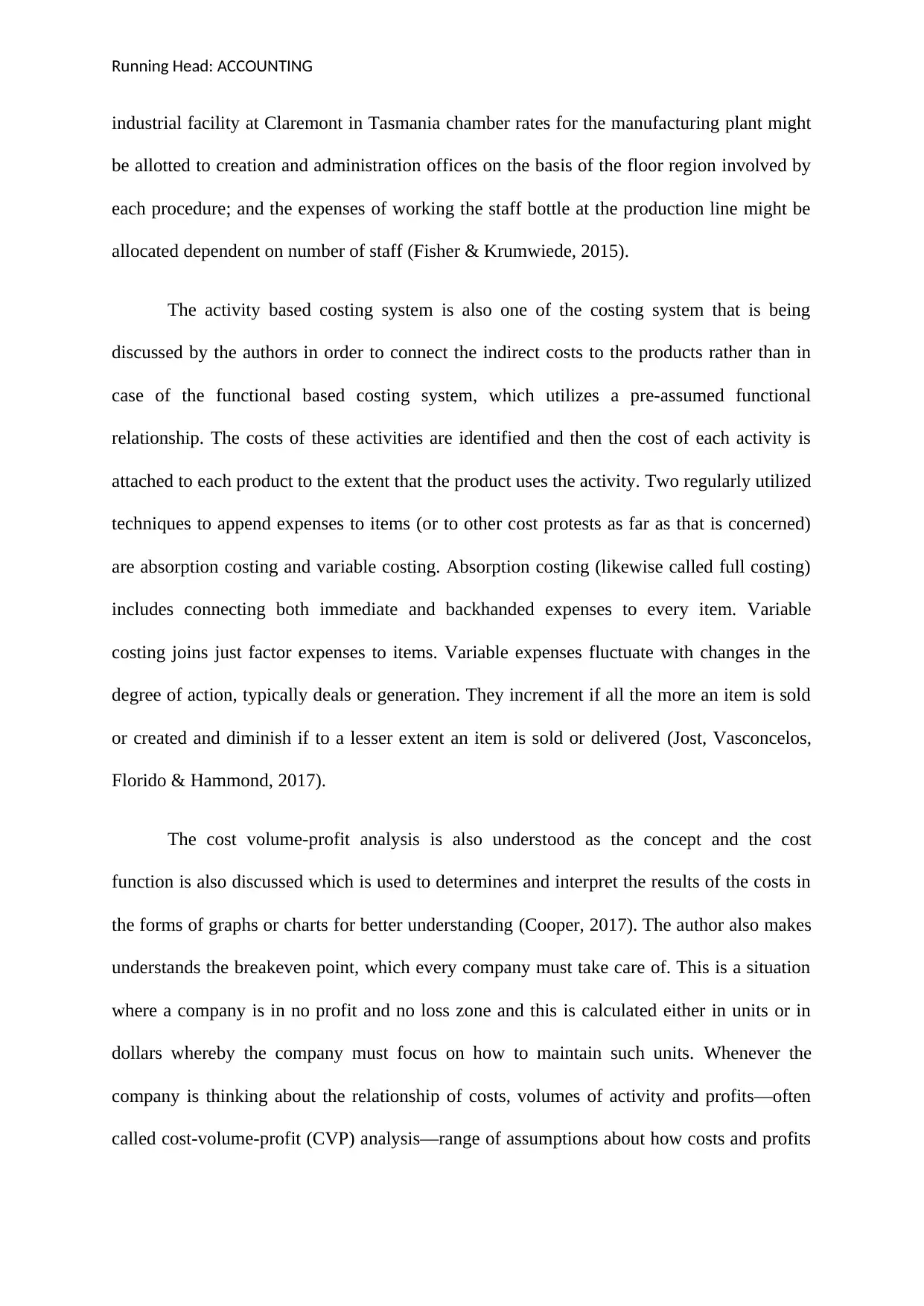
Running Head: ACCOUNTING
industrial facility at Claremont in Tasmania chamber rates for the manufacturing plant might
be allotted to creation and administration offices on the basis of the floor region involved by
each procedure; and the expenses of working the staff bottle at the production line might be
allocated dependent on number of staff (Fisher & Krumwiede, 2015).
The activity based costing system is also one of the costing system that is being
discussed by the authors in order to connect the indirect costs to the products rather than in
case of the functional based costing system, which utilizes a pre-assumed functional
relationship. The costs of these activities are identified and then the cost of each activity is
attached to each product to the extent that the product uses the activity. Two regularly utilized
techniques to append expenses to items (or to other cost protests as far as that is concerned)
are absorption costing and variable costing. Absorption costing (likewise called full costing)
includes connecting both immediate and backhanded expenses to every item. Variable
costing joins just factor expenses to items. Variable expenses fluctuate with changes in the
degree of action, typically deals or generation. They increment if all the more an item is sold
or created and diminish if to a lesser extent an item is sold or delivered (Jost, Vasconcelos,
Florido & Hammond, 2017).
The cost volume-profit analysis is also understood as the concept and the cost
function is also discussed which is used to determines and interpret the results of the costs in
the forms of graphs or charts for better understanding (Cooper, 2017). The author also makes
understands the breakeven point, which every company must take care of. This is a situation
where a company is in no profit and no loss zone and this is calculated either in units or in
dollars whereby the company must focus on how to maintain such units. Whenever the
company is thinking about the relationship of costs, volumes of activity and profits—often
called cost-volume-profit (CVP) analysis—range of assumptions about how costs and profits
industrial facility at Claremont in Tasmania chamber rates for the manufacturing plant might
be allotted to creation and administration offices on the basis of the floor region involved by
each procedure; and the expenses of working the staff bottle at the production line might be
allocated dependent on number of staff (Fisher & Krumwiede, 2015).
The activity based costing system is also one of the costing system that is being
discussed by the authors in order to connect the indirect costs to the products rather than in
case of the functional based costing system, which utilizes a pre-assumed functional
relationship. The costs of these activities are identified and then the cost of each activity is
attached to each product to the extent that the product uses the activity. Two regularly utilized
techniques to append expenses to items (or to other cost protests as far as that is concerned)
are absorption costing and variable costing. Absorption costing (likewise called full costing)
includes connecting both immediate and backhanded expenses to every item. Variable
costing joins just factor expenses to items. Variable expenses fluctuate with changes in the
degree of action, typically deals or generation. They increment if all the more an item is sold
or created and diminish if to a lesser extent an item is sold or delivered (Jost, Vasconcelos,
Florido & Hammond, 2017).
The cost volume-profit analysis is also understood as the concept and the cost
function is also discussed which is used to determines and interpret the results of the costs in
the forms of graphs or charts for better understanding (Cooper, 2017). The author also makes
understands the breakeven point, which every company must take care of. This is a situation
where a company is in no profit and no loss zone and this is calculated either in units or in
dollars whereby the company must focus on how to maintain such units. Whenever the
company is thinking about the relationship of costs, volumes of activity and profits—often
called cost-volume-profit (CVP) analysis—range of assumptions about how costs and profits
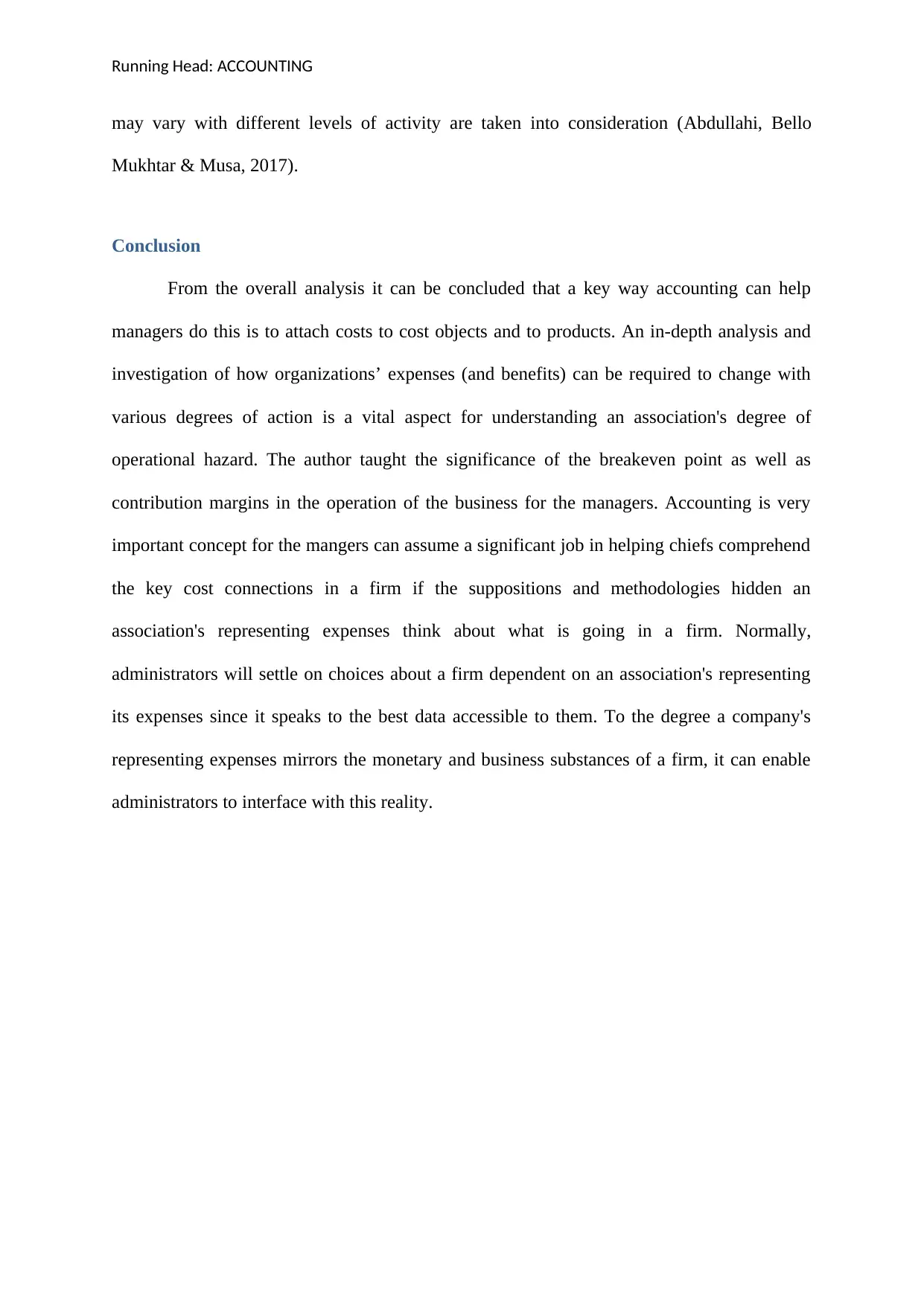
Running Head: ACCOUNTING
may vary with different levels of activity are taken into consideration (Abdullahi, Bello
Mukhtar & Musa, 2017).
Conclusion
From the overall analysis it can be concluded that a key way accounting can help
managers do this is to attach costs to cost objects and to products. An in-depth analysis and
investigation of how organizations’ expenses (and benefits) can be required to change with
various degrees of action is a vital aspect for understanding an association's degree of
operational hazard. The author taught the significance of the breakeven point as well as
contribution margins in the operation of the business for the managers. Accounting is very
important concept for the mangers can assume a significant job in helping chiefs comprehend
the key cost connections in a firm if the suppositions and methodologies hidden an
association's representing expenses think about what is going in a firm. Normally,
administrators will settle on choices about a firm dependent on an association's representing
its expenses since it speaks to the best data accessible to them. To the degree a company's
representing expenses mirrors the monetary and business substances of a firm, it can enable
administrators to interface with this reality.
may vary with different levels of activity are taken into consideration (Abdullahi, Bello
Mukhtar & Musa, 2017).
Conclusion
From the overall analysis it can be concluded that a key way accounting can help
managers do this is to attach costs to cost objects and to products. An in-depth analysis and
investigation of how organizations’ expenses (and benefits) can be required to change with
various degrees of action is a vital aspect for understanding an association's degree of
operational hazard. The author taught the significance of the breakeven point as well as
contribution margins in the operation of the business for the managers. Accounting is very
important concept for the mangers can assume a significant job in helping chiefs comprehend
the key cost connections in a firm if the suppositions and methodologies hidden an
association's representing expenses think about what is going in a firm. Normally,
administrators will settle on choices about a firm dependent on an association's representing
its expenses since it speaks to the best data accessible to them. To the degree a company's
representing expenses mirrors the monetary and business substances of a firm, it can enable
administrators to interface with this reality.
⊘ This is a preview!⊘
Do you want full access?
Subscribe today to unlock all pages.

Trusted by 1+ million students worldwide
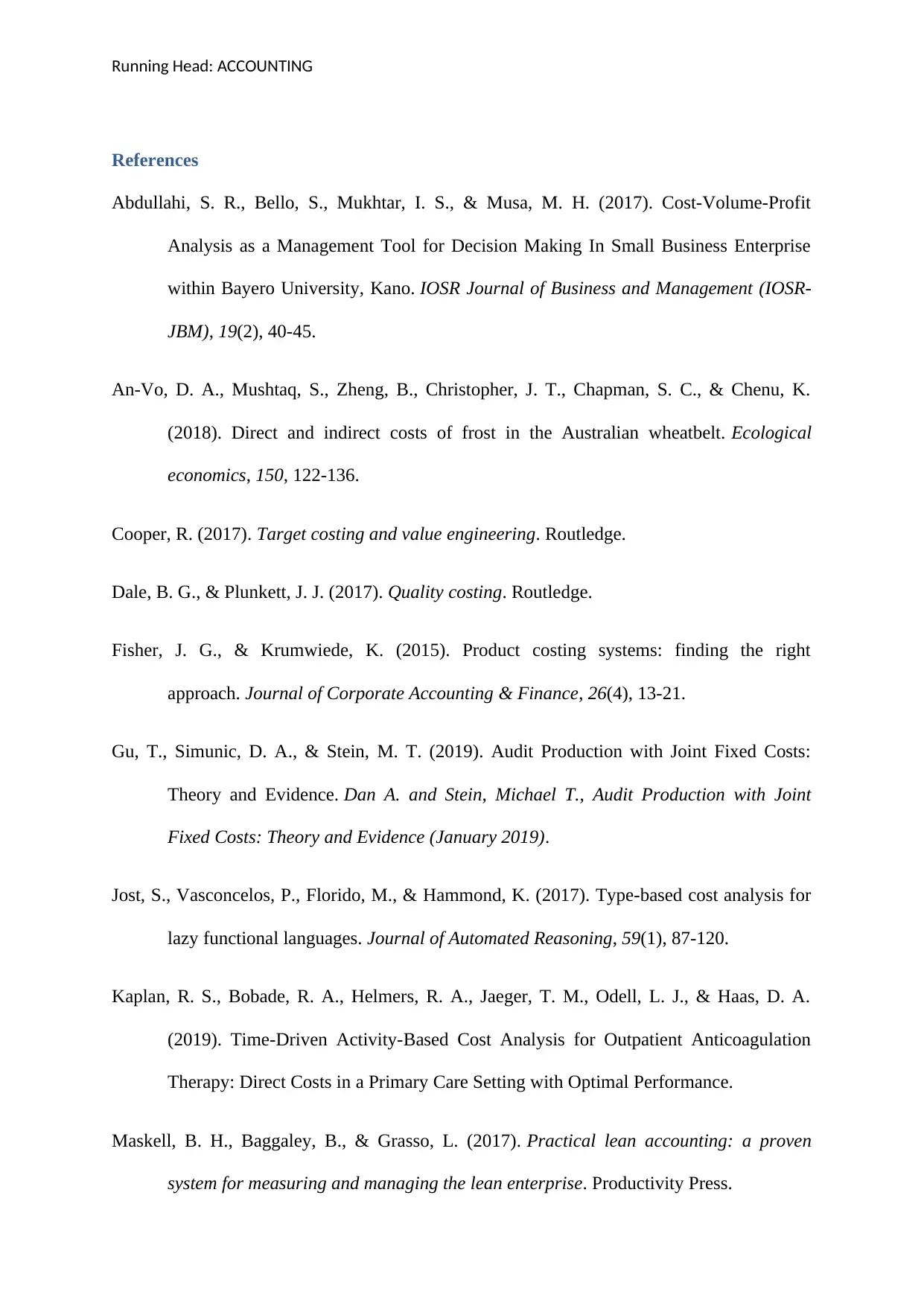
Running Head: ACCOUNTING
References
Abdullahi, S. R., Bello, S., Mukhtar, I. S., & Musa, M. H. (2017). Cost-Volume-Profit
Analysis as a Management Tool for Decision Making In Small Business Enterprise
within Bayero University, Kano. IOSR Journal of Business and Management (IOSR-
JBM), 19(2), 40-45.
An-Vo, D. A., Mushtaq, S., Zheng, B., Christopher, J. T., Chapman, S. C., & Chenu, K.
(2018). Direct and indirect costs of frost in the Australian wheatbelt. Ecological
economics, 150, 122-136.
Cooper, R. (2017). Target costing and value engineering. Routledge.
Dale, B. G., & Plunkett, J. J. (2017). Quality costing. Routledge.
Fisher, J. G., & Krumwiede, K. (2015). Product costing systems: finding the right
approach. Journal of Corporate Accounting & Finance, 26(4), 13-21.
Gu, T., Simunic, D. A., & Stein, M. T. (2019). Audit Production with Joint Fixed Costs:
Theory and Evidence. Dan A. and Stein, Michael T., Audit Production with Joint
Fixed Costs: Theory and Evidence (January 2019).
Jost, S., Vasconcelos, P., Florido, M., & Hammond, K. (2017). Type-based cost analysis for
lazy functional languages. Journal of Automated Reasoning, 59(1), 87-120.
Kaplan, R. S., Bobade, R. A., Helmers, R. A., Jaeger, T. M., Odell, L. J., & Haas, D. A.
(2019). Time-Driven Activity-Based Cost Analysis for Outpatient Anticoagulation
Therapy: Direct Costs in a Primary Care Setting with Optimal Performance.
Maskell, B. H., Baggaley, B., & Grasso, L. (2017). Practical lean accounting: a proven
system for measuring and managing the lean enterprise. Productivity Press.
References
Abdullahi, S. R., Bello, S., Mukhtar, I. S., & Musa, M. H. (2017). Cost-Volume-Profit
Analysis as a Management Tool for Decision Making In Small Business Enterprise
within Bayero University, Kano. IOSR Journal of Business and Management (IOSR-
JBM), 19(2), 40-45.
An-Vo, D. A., Mushtaq, S., Zheng, B., Christopher, J. T., Chapman, S. C., & Chenu, K.
(2018). Direct and indirect costs of frost in the Australian wheatbelt. Ecological
economics, 150, 122-136.
Cooper, R. (2017). Target costing and value engineering. Routledge.
Dale, B. G., & Plunkett, J. J. (2017). Quality costing. Routledge.
Fisher, J. G., & Krumwiede, K. (2015). Product costing systems: finding the right
approach. Journal of Corporate Accounting & Finance, 26(4), 13-21.
Gu, T., Simunic, D. A., & Stein, M. T. (2019). Audit Production with Joint Fixed Costs:
Theory and Evidence. Dan A. and Stein, Michael T., Audit Production with Joint
Fixed Costs: Theory and Evidence (January 2019).
Jost, S., Vasconcelos, P., Florido, M., & Hammond, K. (2017). Type-based cost analysis for
lazy functional languages. Journal of Automated Reasoning, 59(1), 87-120.
Kaplan, R. S., Bobade, R. A., Helmers, R. A., Jaeger, T. M., Odell, L. J., & Haas, D. A.
(2019). Time-Driven Activity-Based Cost Analysis for Outpatient Anticoagulation
Therapy: Direct Costs in a Primary Care Setting with Optimal Performance.
Maskell, B. H., Baggaley, B., & Grasso, L. (2017). Practical lean accounting: a proven
system for measuring and managing the lean enterprise. Productivity Press.
Paraphrase This Document
Need a fresh take? Get an instant paraphrase of this document with our AI Paraphraser
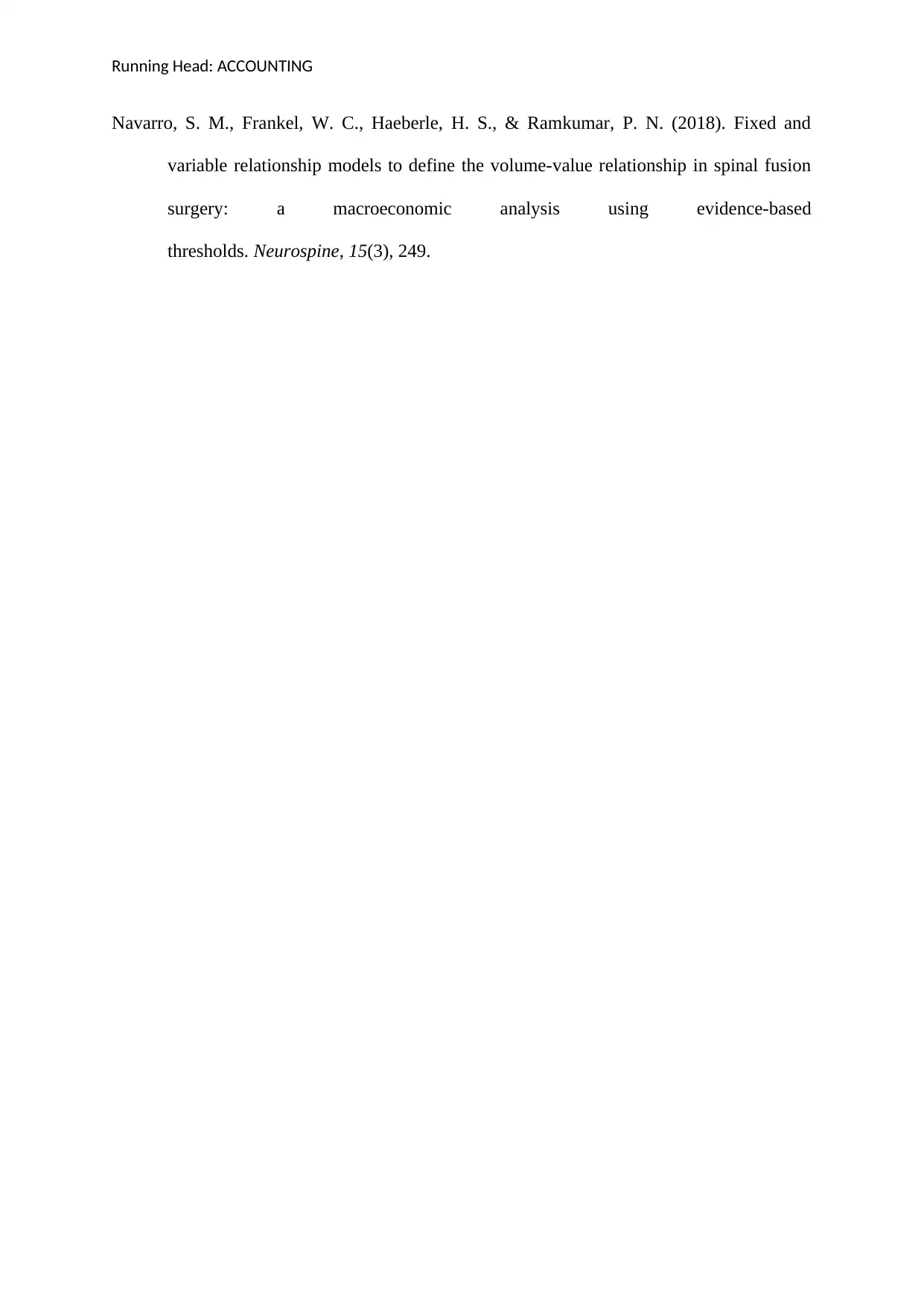
Running Head: ACCOUNTING
Navarro, S. M., Frankel, W. C., Haeberle, H. S., & Ramkumar, P. N. (2018). Fixed and
variable relationship models to define the volume-value relationship in spinal fusion
surgery: a macroeconomic analysis using evidence-based
thresholds. Neurospine, 15(3), 249.
Navarro, S. M., Frankel, W. C., Haeberle, H. S., & Ramkumar, P. N. (2018). Fixed and
variable relationship models to define the volume-value relationship in spinal fusion
surgery: a macroeconomic analysis using evidence-based
thresholds. Neurospine, 15(3), 249.
1 out of 8
Related Documents
Your All-in-One AI-Powered Toolkit for Academic Success.
+13062052269
info@desklib.com
Available 24*7 on WhatsApp / Email
![[object Object]](/_next/static/media/star-bottom.7253800d.svg)
Unlock your academic potential
Copyright © 2020–2025 A2Z Services. All Rights Reserved. Developed and managed by ZUCOL.




